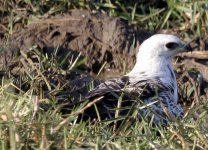compare the SA-buzzard/eagel to this common buzzard
apart from the streaking it looks fairly similar...
http://www.birdforum.net/pp_gallery/data/527/729Wei_er-Riese.jpg
I'm not suggesting it's common but a buzzard spec. still sounds likely
apart from the streaking it looks fairly similar...
http://www.birdforum.net/pp_gallery/data/527/729Wei_er-Riese.jpg
I'm not suggesting it's common but a buzzard spec. still sounds likely
Last edited:





